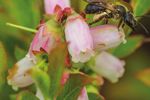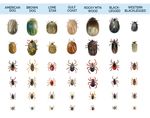TICK SAFETY IN THE BEE YARD - Perennia
←
→
Page content transcription
If your browser does not render page correctly, please read the page content below
JULY, 2020
TICK SAFETY IN THE BEE YARD
As the weather warms up in the spring and into the
fall, there is an increased risk of coming in contact with
ticks. Ticks, like mites, are in the arachnid family and are
considered external parasites. Peak tick season for nymphs
usually occurs during the spring and summer months,
while adults pose a greater threat in the late fall. For
beekeepers, who spend a lot of time in fields and around
wooded areas, the risk is even more prevalent. Ticks live in
long grass, wooded areas, shrubs or leaf piles. They attach
themselves to you or your clothing as you brush by. Even
though they can’t fly or jump, it is surprising how quickly
several can get on your clothing or skin when working out
in the field.
Several species of ticks live in Eastern Canada (Figure
1). It is important to identify which ticks have been found
in your area and be aware of the diseases which may be
carried by those tick species. There are several websites
available for tick identification. Make sure you can
recognize the varieties of ticks and be familiar with what
they look like in different life stages: https://etick.ca/, Figure 1: Tick identification (photo from https://brittalksaboutlyme.
https://www.orkincanada.ca/pests/other/ticks/. American files.wordpress.com/2016/05/ticks.png)
dog ticks are known carriers for such diseases as Rocky
Mountain spotted fever and tularemia. However, it is the
blacklegged tick that is of most concern because it can
carry the bacteria that can cause Lyme disease. To find out
if the blacklegged tick has been found in your area, visit
the following website: https://www.canada.ca/en/public-
health/services/diseases/lyme-disease/risk-lyme-disease.
html#map.
Funders and Contributors:
Bleuets NB Blueberries Nova Scotia Beekeepers’ Association Prince Edward Island Wild Blueberry Growers Association
New Brunswick Beekeepers Association Inc. Wild Blueberry Producers’ Association of Nova Scotia PEI Beekeepers’ Association
1Reducing exposure to ticks is the best defence against EXTRA TIPS FOR BLUEBERRY GROWERS:
Lyme disease and other tick-borne infections. The
• Choose locations for bee yards away from wooded
government of Nova Scotia recommends the following
areas.
tips to reduce your risk of being bitten by a tick: (https://
novascotia.ca/ticksafety/): • Mow long grass in the pollination yard
• Wear long pants and long sleeves in areas likely to have • Mow pathways to bee yards as much as possible
ticks
• If the beekeeper is tending hives during pollination,
• Wear light coloured clothing – it’s easier to see ticks check with them if they can safely access the location
• Wear enclosed shoes and tuck your pants into your • Notify the beekeeper if ticks have been found in your
socks location
• Walk on well-travelled paths, avoiding long grass and If you find a tick attached to you or your pet, there is a safe
vegetation way to remove it to decrease the possibility of an infection.
Follow the directions on the Public Health Services of
• Apply insect repellents containing DEET or Icaridin Canada website or etick.ca. You can also submit ticks to a
(also known as picaridin) to exposed skin and clothes. provincial health laboratory for identification and testing.
Follow directions on the package carefully. Permethrin- Tick testing, however, is not done in all provinces (https://
treated clothing repels and kills ticks when they come in www.canada.ca/en/public-health/services/diseases/lyme-
contact with it and is now registered for use in Canada disease/removing-submitting-ticks-testing.html).
for those 16 years of age and older.
Mount Allison University, under the direction of Dr. Vett
• Check yourself and your family for ticks after being Lloyd, has current research projects underway on Lyme
outside disease in humans and pets. You can also submit ticks to
the Lloyd tick lab for testing. For more information, visit
• Having a bath or shower within two hours of coming the following website: https://www.lloydticklab.ca/
inside makes it easier to spot ticks and wash off
unattached ticks There is also ongoing research on the development of
alternative repellents. Dr. Nicoletta Faraone is working with
• Ticks like warm places on the body. Remember to Dr. Kirk Hillier at Acadia University to develop natural tick
check: repellants (https://atlantick.ca/pages/the-science).
» around ears If you have been bitten by a tick and develop health
symptoms, contact a medical professional right away.
» behind knees Symptoms can arise even after 30 days. Seek medical
attention for the development of a fever, stiff neck, joint
» in the hair pain or muscle aches, sensitivity to light, swollen lymph
» between the legs/groin area nodes, or flu-like symptoms, as these symptoms may
be an indication of a tick-borne disease (https://www.
» around the waist orkincanada.ca/pests/other/ticks/).
EXTRA TIPS FOR BEEKEEPERS: To remain safe in your apiaries, be informed, be vigilant
and follow the recommendations of Health Canada and
• Keep the grass in your apiary mowed short (or lay Public Health Services in your province.
gravel under your hives)
Developed June 2020 by J. Harrison, J. Shaw and R.
• Mow pathways to your apiary McCallum
• Put your hives on pallets or hive stands Funding for the Atlantic Tech Transfer Team for Apiculture
(ATTTA) is provided by the provincial governments of New
• Check your bee suit thoroughly after being in your Brunswick, Nova Scotia and Prince Edward Island through
apiary the Pan Atlantic Research and Innovation Program through
the Canadian Agricultural Partnership, and industry
• Choose your outdoor bathroom location wisely partners including Bleuets NB Blueberries, New Brunswick
Beekeepers Association, Nova Scotia Beekeepers
• Carry a tick kit with you to the field (https://canlyme. Association, Wild Blueberry Producers’ Association of
com/product/tick-removal-kit/) Nova Scotia, Prince Edward Island Wild Blueberry Growers
Association, and Prince Edward Island Beekeepers
Association.
© PERENNIA 2020 JULY 2020 2LINKS AND OTHER RESOURCES: CBC Tick Checklist and Information: https://www.cbc.ca/news/canada/nova-scotia/ticks-lyme-disease-nova-scotia- checklist-1.5103276 eTick App: https://etick.ca/ Nova Scotia Government Tick Safety Website: https://novascotia.ca/ticksafety/ CBC Tick Update in New Brunswick: https://www.cbc.ca/news/canada/new-brunswick/lyme-disease-york- county-1.4722036 Government of Canada Tick Information: https://www.canada.ca/en/public-health/services/diseases/lyme-disease/ removing-submitting-ticks-testing.html Orkin Canada Tick Information: https://www.orkincanada.ca/pests/other/ticks/ Government of Canada Tick Information: https://www.canada.ca/en/public-health/services/diseases/lyme-disease/risk- lyme-disease.html#map Canadian Lyme Disease Foundation: https://canlyme.com/ New Brunswick Tick-Proofing: http://nbtick-proofing.weebly.com/ Centers for Disease Control and Prevention- Preventing Tick Bites: https://www.cdc.gov/lyme/prev/index.html Centers for Disease Control and Prevention- Diseases Transmitted by Ticks: https://www.cdc.gov/ticks/diseases/index. html Atlantick: https://atlantick.ca/pages/the-science LymeNB: http://lymenb.ca/ CanLyme tick removal kit: https://canlyme.com/product/tick-removal-kit/ © PERENNIA 2020 JULY 2020 3
You can also read






















































